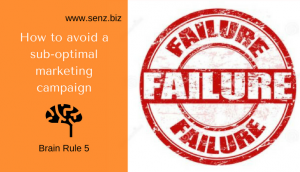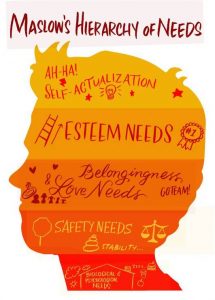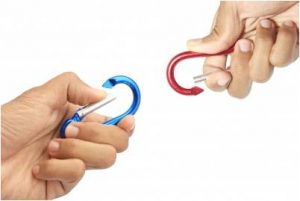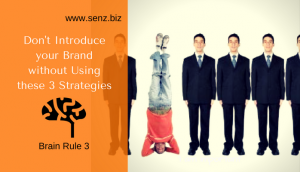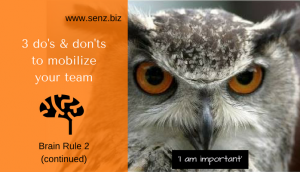- Home /
- brain
Brain Rule 5 – to turn failure into success

How to avoid a sub-optimal marketing campaign
Many marketing-campaigns are sub-optimal. This article covers the 5th brain rule, a very basic one, but many marketers forget to use it in their brand strategy and therefore lose many clients.
Why do people show up at the event of your competitors and not at yours? Why don’t they buy your new vitamin product or invest in your new technology?
Psychology plays a big part when people make a decision. Offering pleasure and a better future is not a main driver to getting them into action. That’s why you shouldn’t focus on pleasing your clients.
What kind of person is most likely to buy a hamburger? Right, somebody who is hungry! Not the people who just like hamburgers or those who have had hamburgers in the past. Although those last two groups could be good leads, too. They need to be hungry… So what does this mean?
Let me give you another example.
Who is most likely to buy your weight management product? An overweight man or a lady who needs to fit into her evening dress to meet her new lover? It’s the lady. Why? Because, like the man who is hungry, she is facing a problem, that she wants to solve.
Avoiding immediate pain is much more motivating than gaining immediate pleasure. This means that, talking about the direct benefits of your product will not immediately grab people at first. When do you immediately take action? Not if you are promised something nice in the future. You take action if you want to move away from a negative situation.
Problems (pains) trigger our urge to survive and make us take action
The 5th Brain Rule says: Focus on the Pain, not on the Pleasure
Your reptilian brain, that takes the decisions, wakes up if there is a problem. It will tell you: be careful, danger! And will immediately be alerted and take action in order to survive.
The 5th brain rule is related to the most basic of all Mazlow’s needs: the need to survive. Haven’t you heard about Mazlow, yet? Read the first brain rule to learn more. The need for survival is the need for food, drink, shelter, sleep and oxygen. If you are cold, sick or hungry you will do your utmost to change this situation.
So, what can you do take bring this rule into practice?
How can you make people decide for your brand, event, therapy, company or hospital, using brain rule 5?
1 Describe the real PAIN
You can press the Survival Button of your clients by describing their pain.
Domino’s Pizza shows a good example. They knew that their consumer’s true pain was not that they didn’t have pizza. The real pain was in not knowing when the pizza would arrive. By installing an online ordering system that tells you exactly when your pizza is on its way, they increased sales exponentially.
So, find out what the real pains of your ideal client are. Ask them, search which posts have many reactions, check which books on your topic score high on Amazon. Mention their problems in your communication, so they will feel understood and feel the urge to take action.
2 Translate your USP’s into Survival Triggers
Translate your USP’s into the impact it has on financials, time, relationships, health or happiness. These have a real impact on your clients.
For example: a kidney clinic helps clients to improve their lifestyle. That’s a USP. How can you translate this into survival triggers? Improved lifestyle can result in less dependence on others and therefore improved happiness. Less dependence on others is a stronger trigger than an improved lifestyle. Also improved mobility and less time that you need to spend on check-ups are strong triggers.
3 Create Scarcity and Urgency
Show your clients that they need to be fast in order to not miss out on your offer.
How this works? Your survival button is pressed when something is taken away from you. You will immediately take action. May be you have heard of FOMO before: The Fear Of Missing Out. This is one of the most impactful psychological strategies you can use to increase the success of your marketing efforts and brand promotion.
People hate it if they miss out of something. A study states that 69%of millennials feel a fear of missing out when they cannot attend some sort of event. This applies to users of all age groups!
So, use phrases like:
Don’t miss out
Only 10 places left
Tomorrow higher price
4 Create Contrast
Be very clear about where you are different than others. This makes it very easy for potential clients to choose for you. This can be done by a contrast-rich description versus the competition, but even better by a picture.
Our reptilian brain, which takes the decisions, is very alert to contrast. Our forefathers were alerted to a sudden movement in a calm landscape or any other change. This helped them to survive.
Brain Rule 5 triggers your customer’s need to survive. This makes them take action. So, it is not about listing the mode of action of your product, what kind of services you offer or even your USP’s. Knowing and listing your customer’s problems triggers them. And offering them a scarce solution that they should pick urgently helps them make up their mind. Apply brain rule 5, help your clients solve their problems and create a unique position!
Do you know more ways to trigger the need to survive? Share them in the comments.
Want to learn more ways to build a leading market position? Click here:
How you add 95% to your influential power
3 Do’s & Don’ts to engage your customers
Don’t introduce your brand without using these 3 strategies
10 ways to increase your revenue through trust
With survival greetings,
Karin
Senz – brand positioning & client attraction, www.senz.biz
p.s. Want more strategies to build a leading market position in the healthcare or services market? Click here to get access to our FREE resources with the newest marketing strategies and Senz & Brain Tips
5 essential factors to get your team into action

Brain Rule 4 for Teams – to make your team follow you
We do not trust our boss! In the corridor employees are complaining: ‘The direction of the company is not clear’, ‘we don’t believe what our manager says.’ Or ‘beautiful plans to build the brand, but the reality is very different.’ It may frustrate you that your employees don’t get it and don’t take the required action. Apply brain rule 4 to make your team trust and follow you.
The problem may be that a consistent message, that touches them, is missing. People need clarity and guidance. Probably, you remember the feeling that something is not right, if somebody tells you a lie. The first thing that happens is that your brain warns you that you are in danger. It starts producing a strain of counter-arguments.
Safety is one of the core needs. If insecurity and danger and therefore anxiety arise, this leads to action; but not in the right way. It leads to either fight or flight. Fight in this case means: working harder, or show that you are more important than others; and internal competition. Flight means: if they don’t see or hear me, nothing will happen. I just do my own thing and do not show myself.
Internal conflicts, stress and slowdown are the result. This unproductive process is going on in many companies. So, how can you deal with this as a leader?
Consistent messages that create a feeling of safety, inspire teams (and clients) to follow you. Subconscious counter-productive mechanisms in your brain will be over-ruled. Some leaders happen to be the ones that are followed by many people. They inspire their environment, so many team members feel the drive to perform. You can also make this happen!
Brain Rule 4 says: Establish a Safe Setting
This is important for clients, as well as for employees.
Read the 10 easy ways to make clients trust you and increase your credibility (and revenues).
These are the 5 essential factors how you can make your team trust you, and get into action.
1. Be the living example of your message! A big desire of employees is to have a role model, somebody to identify themselves with. However, if they receive different conflicting signals, people will get confused. Like in a company where the CEO told his team that customer orientation needs to be improved. Every day, he parked his car at the place for… clients! So, do what you pray!
2. Be consistent yourself; match your feeling, thinking and behavior. I remember a meeting where a manager jumped up with a red face and started to defend his point of view. One of the team members noticed: you seem to be very angry at us. He shouted: I am not angry. With denying your feelings, you may seem a rational leader, but you actually betray yourself; and others.
Other people immediately notice what is going on. This is due to your mirror-neurons in your brain. These are nerve-cells that notice and mirror the emotional state of mind of others. This means that your team members will immediately feel what you feel. So, realize what you really feel and think while you are sending a message. And be honest: do they match with each other?
3. Let your heart speak! This has an amazing effect! Without feeling, no passion. Without passion, no action. Managers need awareness of their own feelings as a precondition for effective leadership. This way, they will be perceived as authentic and trustworthy.
4. Listen to your team members. Recognition creates a safe environment and takes away 50% of all problems.
5. Send at least 7 consistent messages about the same topic (of course in a slightly different way). You may know that you need this to help prospects take action. However, the same is valid within your organization. You will immediately notice the effect.
Implement brain rule 4 and establish a safe setting for your team by speaking and acting from your heart. This makes them follow you and take action.
Do you know more ways? Share them in the comments.
With trustworthy greetings,
Karin
Senz – brand positioning & client attraction, www.senz.biz
p.s. Want more strategies to build a leading market position in the healthcare or services market? Click here to get access to our FREE resources with the newest marketing strategies and Senz & Brain Tips
10 easy ways to increase your credibility

Brain Rule 4 – to be trusted and increase your revenues
‘I just don’t trust this clinic. I had a bad experience with this company’. ‘I still need to think whether I should go with this brand OR ‘I recommend this brand to everybody’. ‘It was a very easy decision to choose this product’. How can you move from one set of reactions to the other? Use brain Rule 4.
It’s clear that your client can benefit of your offer. Your anti-aging therapy clearly offers what the client is asking for. Your training delivers the education your customer needs.
And still…. your client does not buy. It seems to take ages before they take a decision. What’s going on?
It could well be that they (subconsciously or not) have doubts whether you indeed will deliver what you have promised. The feeling of safety and security is one of peoples’ basic needs. And it is one of the triggers that makes our reptilian brain take action.
You first need to create a setting where clients feel safe, to make them trust you. It will be much easier for them to buy (and keep buying) your product.
Brain Rule 4 says: Establish a Safe Setting
Brain Rule 4 is very closely related to the human need for safety, according to Maslow’s hierarchy of needs. This is a theory of motivation in psychology developed by Abraham Maslow. Maslow believed people move through different stages of five needs that motivate our behavior. He called these needs physiological, safety, love, esteem, and self-actualization.
I refer to them as the 5S-needs to touch the heart and brain of people: Survival, Safety, Social Belonging, Self esteem and Self actualization.
The need for safety has to do with our natural desire for a predictable, orderly world that is somewhat within our control. In order to fulfill this need, you need to apply Brain Rule 4.
10 easy ways to establish a safe setting &
increase your credibility (and revenues)
1. Be who you are. Do the things that belong to your company. Introduce products that fit into your portfolio, promote them the way you are: funny, serious, credible, fancy… Be authentic.
2. Make the total experience more personal. People trust people they know. That’s why networking and MLM companies do so well. People don’t trust strangers. Why would they?
Help your prospects get to know you. Share personal stories, show who is behind the idea/brand, use your own picture and name in brochures, online and in emails; a personal touch makes the difference.
3. Speak to your clients in an informal way, just like you do in your private life. Don’t be too corporate. If you are easily accessible (if clients feel they can talk to you), it’s easier to trust you.

4. Give clients the chance to sniff at you through an easily accessible acquaintance. Why would companies give free samples, share free information, or offer a free trial period? This helps prospects make informed decisions and feel safe.
Click here to receive my FREE client attraction course 😉
5. Give clients the chance to step-out if they don’t like it. Give them a Money back guarantee if your product does not work for them. This shows that you are not right after their money, but want to offer them value.
6. Send at least 7 consistent messages or try to call your prospects 7 times. To help a prospect take action, you need on average 7 contacts. People tend to forget about this. One message is NO message. Use a system that takes care of this and sends the messages at the right time to the right person and the right moment. This will simplify your life.
7. Use the safety claim in your promotion (if your product is safe indeed). How can YOU offer security? No side-effects, qualified doctors, guaranteed efficacy?
8. Over-deliver. Do what you promise and more. This could be that you finish the project early and beat the deadline, add in some unexpected extras, remember people on important days, keep in contact even if the deal is done.
9. Use testimonials and recommendations. Others can sell you better than you can yourself. And moreover, this is more trustworthy. So it does make sense to collect likes ;-).
10. Welcome feedback of your clients and listen to them. Even if it is negative. Don’t tell your customers that they are wrong. Offer them your ear and use the info to even get better.
Do you know more ways? Share them in the comments.
If you implement brain rule 4 and establish a safe setting for your clients, it will be much easier for them to make a fast decision to buy your brand.
With safe greetings,
Karin
Senz – brand positioning & client attraction, www.senz.biz
p.s. Want more strategies to build a leading market position in the healthcare or services market? Click here to get access to our FREE resources with the newest marketing strategies and Senz&Brain Tips
7 strategies to turn negativity & passiveness into initiative
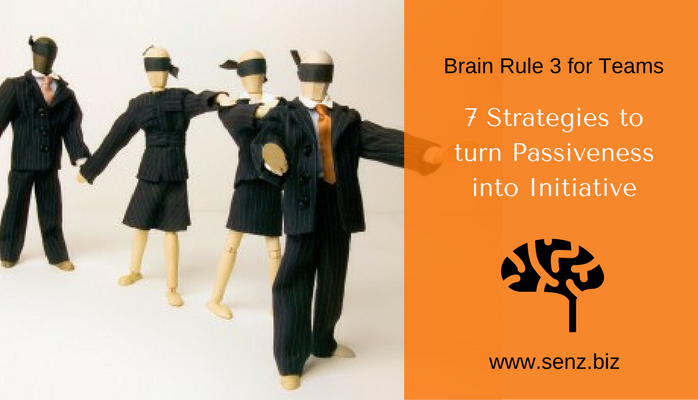
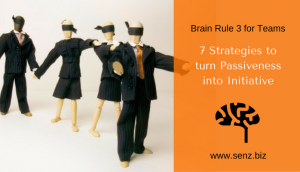
Brain Rule 3 for teams: to Increase the Initiative in your Team
Your employees are complaining that there is a lack of direction. They don’t feel motivated anymore.
Especially now, it’s important that they take initiative and do a better job than ever before.
Brain Rule 3 helps you get the initiative back in your team and increase the productivity.
As a leader you feel that your strategy is clear and you don’t understand why your employees don’t get it. Sales are lacking behind and something needs to happen. Otherwise, it is even necessary to start a re-organization and dismiss people.
You have tried a lot: you spoke with them, gave them clear assignments and maybe even a training. However, nothing really changed.
What is going on?
-Your employees really don’t know the direction. Leaders think that everybody knows it, but this is NOT the case. Research (CIPD) showed that out of 2000 employees only 29% knew the values and strategies of their company.
-It could well be that your team feels that the management goes into a direction they do not want to identify with
-Or maybe some of your team members know that they are nominated to be dismissed
-Or they feel that they are not valued anyhow
In all cases, this means that the connection between your employees and the company is lost. They do not feel that they belong to the company anymore (although they are employed).
You are not meeting one of the strongest forces in universe: ‘social belonging’. The importance of belonging to a group is not always immediately recognized. However, it has disastrous consequences for a company if this aspect is lacking. Our mental system is programmed to belong to a group. If this does not happen, our brain sends signals that feel like a punishment.
This leads to negativity, passivity, feelings of burn-out and demotivation. The loyalty to the company will drop with a negative impact on sick leave, employee turnover and productivity.
This can last for months and even years. No wonder that the clients feel this; with a negative effect on the bottom-line.
So, how can you get all noses into the same direction?
How can you make everybody feel responsible and take action?
How can you turn negativity & passiveness into initiative?
Restore the connection and make use of:
Brain Rule 3 for teams: create a sense of belonging
This is a proven recipe
Click here if you want to know how you can use brain rule 3 for clients.
7 strategies for leaders to turn negativity & passiveness into initiative:
1. Make clear what you stand for and what is your strategy
Communicate this message consistently and show it in actions. In the end, nobody wants to stay behind.
2. Be even clearer about what you expect of your employees.
Tell them what their added value is. Even in a period of re-organisation.
3. Create an enthusiastic (and big enough) group of pioneers, if you want to introduce new strategies.
Others will follow.
4. Mention the commonalities in your team and make clear where you are different than others.
People always prefer their own group above others.
5. Make clear to what group they belong if they take the wished actions.
Make also clear that you are also part of the group and lead by example.
6. Set concrete short-term objectives, so everybody can immediately notice the effect.
This way, you are positively influencing the intrinsic motivation, satisfaction and output. This does not work with abstract objectives that are too far away.
7. Give regular feed-back about the progress that has been made.
This way, people function in the best way (Amabile, Harvard University).
Do you know more strategies? Share them in the comments.
If you implement brain rule 3 in your team, you will immediately notice the impact on the productivity, teamwork and motivation. If this is lacking, this will lead to loads of stress, dissatisfaction and demotivation.
With connecting greetings,
Karin
p.s. Want more strategies to build a leading market position? Click here to get access to our FREE resources with the newest marketing strategies and Senz & Brain Tips
Brain Rule 3 – don’t Introduce your Brand without Using these 3 Strategies
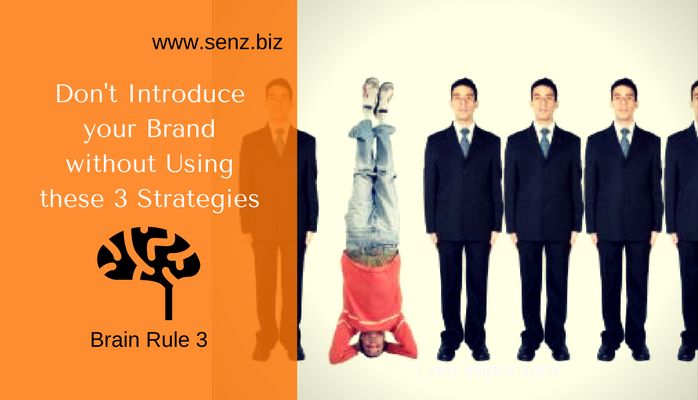
Brain rule 3 – to make clients love your brand
The whole day, your clients are influenced by millions of triggers. So, how do you get into the mind & heart of your clients, if you are one out of millions? How can you make clients love your brand?
Brain Rule 3 plays an important role!
The good news is that our reaction to triggers is programmed in our brain. Scientists do not know yet how it all works, but what they know is that it started long ago.
This makes me think of the following cartoon:
A HR-manager asks a monkey:
Do you want a salary increase of 100%, 20 extra free days, a pension and a bonus of 100.000 Euro?
Or do you want this banana?

Oh dear, the monkey chooses subconsciously for the banana!
We are 100% similar to this monkey. Also we, and our clients, follow our primitive urges.
Successful marketers and leaders acknowledge these primitive urges and deeper needs of people.
This time, we take a look at one of the most important needs of people, one of the strongest powers in the universe.
Why do you hear laughing during comics?
Why do you follow the latest fashion trends?
Why do you take a look at your neighbor if you don’t know how to use your cutlery?
We are programmed to stick together. Every person subconsciously wants to be part of a group, which has something in common; really, also you. ‘Belonging to a group’ and being a valuable group member, is a matter of live or die. If you deviate from the majority, your brain will release a signal, which feels like a punishment.
This is a very important brain-principle, which drives our behavior; and a very strong element to attract clients. Our need to belong to a group is so big that people even decide to connect to sects, radical groups and terroristic gangs. This brings us to Brain Rule 3.
Brain Rule 3: Create a group of like-minded clients
This rule is closely related to Mazlow’s need to belong.
Having solid social connections can be as important to human health and happiness as having food, water, and shelter. Research shows that your odds of survival increase by 50% by having social relationships. This effect is comparable to the effects of smoking and excessive drinking on mortality, suggesting that having quality social ties is vital to our lives.
Okay, let’s list the 3 strategies to tap into the need of social belonging:
1. Focus on a specific group of people and share who they are.
Most likely to buy your products are people who share the same personality, beliefs and the same WHY with you.
2. Make clear what makes you different than others.
People love their own group more than others.
3. Share who is already buying/liking you.
People with the same profile are likely to follow.
This is a great example how Brain Rule 3 works. Want to try?
A hotel tested several messages to make guests use their towel more than once. Which one had most effect?
1. Help the hotel save energy
2. Let’s together save the environment
3. Just like other guests, help to save the environment
4. Just like other guests, help to save the environment (75% of the guests in this room participated in our savings-program)
5. Use our energy sources sparingly, think about our future generation
6. Help to save the environment
This is how people will start loving your brand. They will feel it’s their brand, since it says so much about them. Ogilvy calls them Lovemarks; and Lovemarks transcend brands. They reach your heart as well as your mind, creating an emotional connection that you just can’t live without.
Take a brand away and people will find a replacement. Take a Lovemark away and people will protest its absence. Lovemarks are a relationship, not just a transaction. You do not just buy them, you embrace them passionately. That’s why you never want to let go.
It is clear that using brain rule 3 creates Brand Love and Brand loyalty, which can be very profitable.
Do you know more ways to implement Brain Rule 3: Share them in the comments.
With love,
Karin
#1 Strategy to build a leading market position

A short presentation to show why companies miss to become a market leader. You will also learn how you can add 95% to your influential power.
Brain Rule 2 – how to increase your team’s productivity by 50%
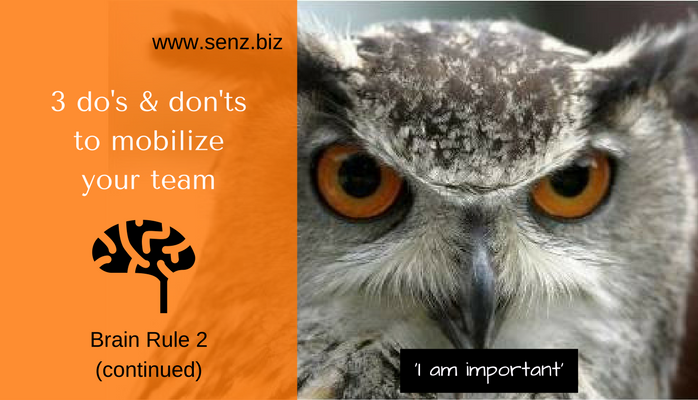
To Increase your Team’s Productivity
How can your clients be inspired if your employees aren’t inspired? This is the question, I have asked many teams. This has also been researched thoroughly. It can be concluded that the productivity and profit of teams can be increased by 50% if brain rule 2 has been applied.
What if your clients are not being treated like a king by your team-members?
What if your employees don’t love their company and their role?
What if your team is perceived differently than you aim for?
You are positioned as this service oriented, fast and kind company. However, if there is a complaint… your customer service employee does not listen and even becomes angry. Your business development manager makes promises he cannot make come true. And you are not able to deliver your products in time. This ruins the company!
You may know this story. I love it!
One day, Bob, the CEO of a hospital, was walking down the hallway. He came across a singing cleaning lady working. He stopped to talk with her for a few moments and eventually he asked the lady what she did.
The cleaner stopped, turned to Bob with a completely serious look and replied, “I save lives”. Bob was taken aback. What was this lady talking about? She’s the cleaner, not a heart surgeon.
She continued, “See, when I do my job well and clean the operating rooms and other work areas, the doctors have a sanitary, safe place to do their jobs. I clean things, yes, but in the bigger scheme of things, I’m helping to save lives”. Bob, the CEO instantly realized his own “small thinking” and saw that the cleaner had a view of the mission of the hospital from an entirely different, yet valuable, perspective.
This means that brain rule 1 (share WHY you exist, your higher goal) is in place. This lady is fully committed to the higher goal of the hospital.
Also brain rule 2 (value & recognize your clients & employees) has been implemented. Her self esteem is high, she feels valuable. This makes a big difference. Do you think that this lady will clean the hospital better or somebody who feels demotivated?
For the ones who like numbers, did you know that:
– The productivity of teams increases with 50% if each team member fulfills the role they are good at. In a car factory, 2 teams were selected. Each team member listed their qualities. These were shared with everybody. Then, they got the tasks matching their qualities. 6 month later, the productivity of these 2 teams has improved by 50% versus the unchanged teams.
– Productivity and profit increase in more inspired companies. A study under 8000 business-units of 36 companies in US measured the inspiration versus the profit of the company. Both productivity (+80-120.000 dollar per month) and profit (+1-4%) were higher in the more inspired companies.
Brain Rule 2: Value & recognize your clients & employees
Let’s take a look at what the 3 do’s and don’ts are
to increase the inspiration & productivity of your team.
1. Listen openly to your team-members’ ideas
Don’t: Ask for their opinion and never get back to it, or tell them they are wrong. They will never open up to you again.
Do: Take their ideas seriously & see how they can complement your own ideas. Give them feedback.
Easy Win: Ask a few of your team-members what is the most important hurdle to get more clients. Listen to them and acknowledge them for being that honest. Adjust your strategies and messages accordingly. Otherwise, their brain will protest and they will sabotage your plans.
2. Make sure all team-members know and feel the added value of the team
Don’t: Think and show that your team is not important or capable. It will be a self-fulfilling prophecy.
Do: Keep the spirit high by sharing the importance of what you are doing. Everybody in your team should know what the company & clients miss if you wouldn’t be around.
Easy Win: Share in every assignment that you dedicate to your team (yes, also in your e-mails) why this is relevant to the company’s success.
3. Make sure that you recognize the added value of each team-member
Don’t: Chase your team-members on things they are not able to do. It will be both frustrating for you and them.
Do: Recognize the strength of each of the team-members. Make sure everybody knows about it. Make use of the feeling of being a winner.
Easy Win: Let you team members list their qualities. Share them with the rest of the team. Then, give them tasks that match their qualities. If you need somebody to make a presentation, ask the one who is good at this. If you need a spreadsheet with numbers, ask the one who really likes this. You will be amazed what will happen!
If you implement the winners’ mentality in your team, the productivity will quickly improve. Yes, I know, there are always other priorities: your daily activities, the report to the board, the launch of a new product. However, don’t forget: an inspired team can do 50% more. What is a better investment?
You can read here how to use this Brain Rule to engage your customers.
Any other inspirational tips for teams? Share them at the comments section.
With teamwork greetings,
Karin
Brain Rule 2 – 3 Do’s & Don’ts to engage your customers

For Ultimate Client Binding
Have you ever asked yourself why some sales reps and business people sell more than others?
Why they have more loyal clients? How they were able to build a unique position?
They use brain rule 2!
I had to order new business cards and stopped at a few print shops. Pretty amazing how they treat their potential clients! One found his food more important than me, the other just mentioned the price and showed me his own, ugly 😉 business card.
Then, a friend advised me to go to Jameson.
This business-card-specialist touches the paper with love and explains the differences between mat and shiny cards full of dedication. So, he obviously loves his job and believes in his product. But there is more… he also asked me questions about my preferences, about my business. He listened to what I find important. He made me feel important. I matter to him.
The same goes for top salesmen. Many salesmen talk a lot, but have you ever noticed that the top salesmen actually listen more and are really interested in you?
This brings me to:
Brain rule 2: Value & recognize your clients & employees
Even if you do not always realize, everybody needs attention, recognition and to be valued. Your reptilian brain, the part of the brain that takes your decisions, is very self-centered (learn more about the reptilian brain). It feels: I am the only important person on earth. It needs attention and acknowledgement.
It has already been said that the brain rules are very closely related to
Mazlow’s hierarchy of needs. See Brain Rule 1.
The 2nd brain rule is very closely related to self esteem.
We all desire to be accepted and valued.
So, what are the 3 do’s and don’ts to value and engage your clients?
1. Listen more than you talk
Don’t: Just talk about yourself and your product. Don’t try to impress them by your knowledge.
Do: Listen to what your clients really want. Ask questions and listen to their answers. Impress them by your understanding.
Easy Win: Notice today how often you ask a question (it all starts with awareness).
2. Use more ‘YOU’ than ‘I’ or ‘We or ‘Our product’ at your website
Don’t: Just talk about yourself & explain about your product or service.
Do: Talk to your clients, say you. Talk about the gains/benefits for your client.
Easy Win: Search for ‘I’, ‘we’ or ‘the name of your product’ at your website. And see how you can replace this by ‘You’ or ‘Your’.
3. Recognize the point of view of your clients
Don’t: Just try to convince them about your product.
Do: Get involved in your clients. Understand where they are coming from. Give them the opportunity to interact and react. Each piece of information should be about them: from their point of view! Mention the problems/issues/ struggle of your clients. Use their words.
Easy Win: List the issues of your previous and current clients (in their words). You can also do this with your team. How can you use this information to adapt your acquisition, your website, your sales talks and/or your offer?
This is how you can start engaging your clients. Make them feel important! This way you build a unique position.
But what if your team members don’t make your clients feel valued?
What if they don’t feel valued and engaged themselves?
What are the do’s and don’ts in this case? I will share this with you next time (brain rule 2 continued).
With engaging greetings,
Karin
Brain Rule 1 – How you add 95% to your influential power

To Inspire your Clients and become a Leader
Here is the big idea in 86 words
There is a big disconnect between how you sell your products and how it is received by your clients. As a result, 9 out of 10 times your important messages don’t get through. Messages are sent from the smart and new part of the brain. But they are received by the part that is 5 million years older (and not as bright). This is a serious problem if you want to be successful. You need to understand why this disconnect happens in order to overcome it.
Although we think that decisions are being taken by our rational brain, this is not true. Research shows that 95% of our decisions are actually driven by our subconscious mind. This subconscious mind sits in the most primitive part of the human brain, called the ‘reptilian brain’.
Many of our survival mechanisms are ‘saved’ in the reptilian brain, like our instinct and our fight and flight mechanisms. It takes care of our blood pressure, breathing, immune system, but also of our emotions, humor and behavior. The reptilian brain has its own life and does not listen to the rational parts. If you try to sell your products based on rational info alone, you only use 5% of your influential power.
By triggering the reptilian brain, you can talk to the heart and minds of people. I will share ‘proven brain rules and tips’ with you to trigger the reptilian brain and add an extra 95% to your influential power. In this article, you find brain rule 1.
Have you ever heard of Bart de Graaff?
When you look him up, you will read the story of a Dutch 9 years old boy,
who was run over by a car, lost his leg, and developed a kidney problem (because of bacteria)
and a growth disorder.
When he was 20 years old (and still looked like a small kid) he took part in a funny TV-advertisement and was asked to make an own program for one of the biggest Television Channels in Holland.
After that, he started, as a jolly, extravert brat a new public television channel: BNN: Bart’s News Network (with a wink to CNN).
Their programs shared stuff that you usually don’t talk about, they made fun about things
(also about himself), that you usually avoid mentioning.
He wanted to show that you should live life to the fullest, nothing should limit you and hard things should be confronted. He spent more time in the hospital, than outdoor, but still he continued making programs full of energy and enthusiasm in his own playful, shocking way.
This way, he developed his own successful empire with engaged team members and spectators
(read: clients).
There is a reason why some people and companies, like Bart with BNN, have so much energy and are so successful. They attract clients who trust them and want to belong to them. Opportunities and clients come to them, spontaneously. Bart has a mission, a higher goal; he has something to share with this world. And he connected himself to this with his heart and soul.
Brain rule 1 is: Share WHY you exist, your higher goal.
Have a clear and inspiring message. What do you have to offer as a company, team or individual? Those who know their WHY are the ones who lead. They are the ones who inspire. It’s definitely worthwhile to read Simon Sinek’s bestseller: ‘Start with Why’.
It’s remarkable that the brain rules are very closely related to
Mazlow’s hierarchy of needs.
Do you remember this impactful model?
This first brain rule is very closely related to self actualization. This level of psychological development can be related to finding a meaning in life. And this is exactly what you are offering with you WHY. A WHY triggers the internal drive of people.
Can you imagine how this positively impacts your clients and employees? And yourself 🙂?
Companies with a WHY are very inspirational and attract employees and clients, spontaneously. They have created their own niche, their own space in the market, they focus on a specific group and you immediately recognize them by their approach and style. Their group of clients wants to belong to this and will be loyal fans and clients. This also means that a premium price for specialized services and products is possible. On top of this, team-members love to work for this kind of companies; they feel engaged and each of them feels part of the success.
I worked with quite a few brand- and company owners who are passionate about what they want to achieve in this world. Stefan invents products to improve quality of life for the disabled. Jeffrey wants to shape habitats for poor people in Brazil by selling investment funds, Thomas wants to make the world a little better by his health innovations. Big ideas! I believe they can make the difference!
One of my favorite examples is Dove. They have a clear WHY and are extremely successful. They advocate that every woman is beautiful. This brand is honest, pure, feminine, optimistic and confident. They show this everywhere: in their packaging, advertising and in their Dove self-esteem project. This project helps young people develop a positive relationship with the way they look. They are highly successful.
Finally, let me share my own experiences. In my first job as brand manager of a product to relieve cancer pain, I realized how many people are suffering of chronic pain and how this impacts their life. My mission was not to sell as much of this product as possible, but to really help those people with pain, to give them a place to go to, to educate care providers, to give them the tools to relieve their pain. The side effect: we became market leader in the Netherlands. Also in other fields, like urinary incontinence and BPH, my team and me developed programs to support ‘patients’ to not feel ashamed and improve their quality of life. This way, my team made 4 products the global market leader! Now, I help companies, who also have a mission, to attract more clients. That’s my mission!
With mission greetings,
Karin

